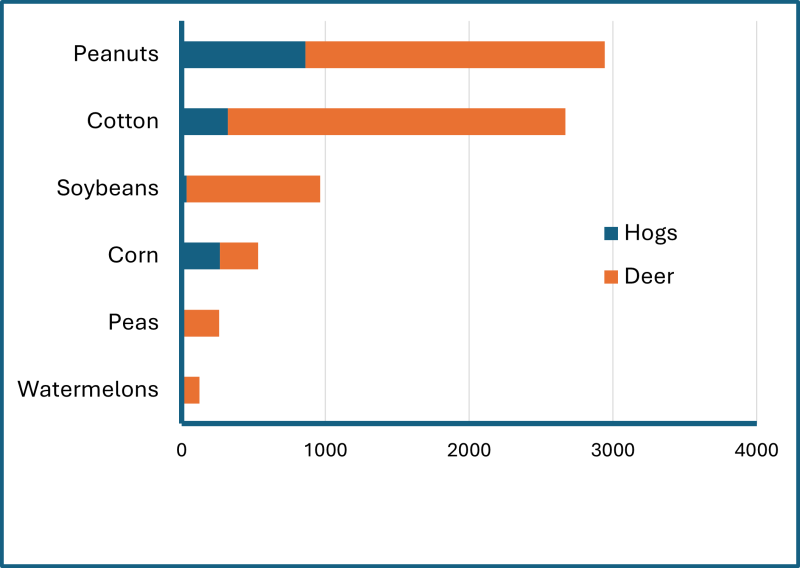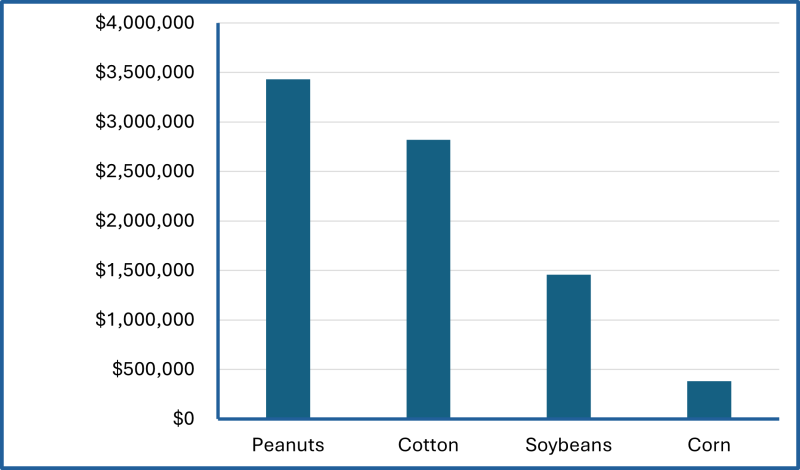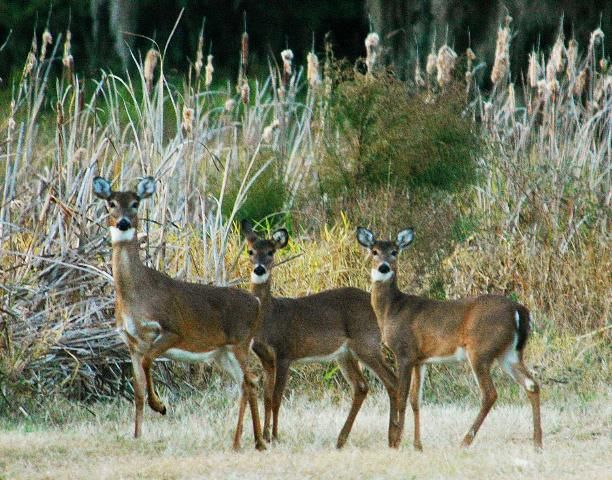Samantha M. Wisely, Wildlife Extension Specialist, University of Florida

Figure 2. A newly planted cotton field. Seedlings have been stripped by white-tailed deer. Credit: Georgia Farm Bureau
White-tailed deer (Figure 1 above) are the most popular game species in Florida, and many Floridians actively promote their presence on their properties. Although wildlife are a valued natural resource, white-tailed deer can also be an expensive nuisance to row crop farmers. White-tailed deer populations have nearly doubled in the past 30 years and habitat has decreased due to urbanization and development. These changes have increased the number of deer that forage on agricultural lands leading to crop damage (Figure 2 right). Due to the size of the agricultural landscape and the high abundance of deer, crop damage is especially severe in the Florida Panhandle.
A survey of 69 farmers in the Panhandle who owned or leased a total of 53,245 acres (Ober et al. 2021) suggests that damage by white-tailed deer is extensive and increasing. Nearly all farmers (94%) reported damage by deer. Peanuts were the most affected crop by acreage followed by cotton. soybeans, corn, peas, and watermelon were also impacted (Figure 3 below). Watermelon damage by acreage was small compared to other crops, but white-tailed deer damaged almost 30% of the planted acreage of watermelon. Although the majority of the damage was inflicted by deer, wild hogs also damaged crops. This trend is not unique to Florida; nationwide surveys report similar findings.

Figure 3. Six crops in the Panhandle of Florida and the acreage that was damaged by white-tailed deer or wild hogs in 2009 and 2010 (data from Ober et al. 2021).
–
In two years of production, the 69 producers reported 7,614 acres of crop damage. This resulted in a total of more than $8 million in monetary losses to these farms (Figure 4 below). These values underestimate actual losses because they do not account for the cost of replanting or of wildlife damage control efforts.

Figure 4. The estimated monetary loss to four major agricultural crops due to white-tailed deer or hog damage on 69 farms in the Florida Panhandle in 2009 and 2010.
–
Farmers reported using a number of wildlife damage management efforts including shooting (either via hunting or depredation permits), chemical repellents, flagging, fencing, frightening devices or trapping. Nonetheless, damage was extensive at these farms suggesting that additional management actions are necessary to reduce damage to agricultural crops.
Florida Fish and Wildlife Commission has two different permits available to farm owners or lessees. Farmers experiencing deer damage may apply for an Antlerless Deer Permit which allows hunts for either sex to be conducted during established deer hunting seasons. Antlerless hunts can reduce overall white-tailed deer populations on properties. The second type of permit is a Deer Depredation Permit that allows for killing deer that are causing damage to agricultural crops. Both of these permits have special allowances and prohibitions. An FWC Wildlife Assistance Biologist can provide additional information about these permits and help to determine what type of management action is best for a particular situation.
Note: Building on an effort initiated by Dr. Camp Hand at UGA, a team of UF/IFAS researchers lead by Dr. Carolina Baruzzi have an on-farm study underway looking to quantify the yield impact of deer herbivory on both cotton and peanuts. The study began in the 2024 growing season, so no data is available at this time.
–
Additional Resources
Ober, H.K., Edmondson, G.R., Giuliano, W.M., Wright, D.L., Atkins, J., Andreasen, A., Eubanks, S., Johnson, L., Brasher, C. and Hicks, G., 2011. Farmer Perceptions of Wildlife Damage to Row Crops in North Florida: WEC311/UW356, 7/2011. EDIS, 2021(8).
Deer Depredation in Florida Panhandle – Florida Farm Bureau Florida Agriculture April 2024 eNewsletter
Study confirms cotton farmers face major deer problem – Southeast Farm Press
FWC deer depredation permits
FWC antlerless deer permits
FWC Northwest Region Office contacts
- How Landowners Can Help Gopher Tortoise Conservation in the Florida Panhandle - August 29, 2025
- Armadillo Biology, Management, and Disease in the Panhandle - February 21, 2025
- Crop Damage from Deer in the Panhandle - August 15, 2024

